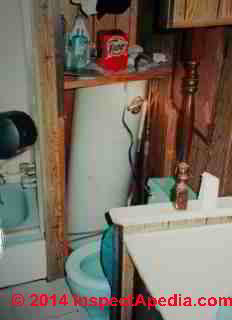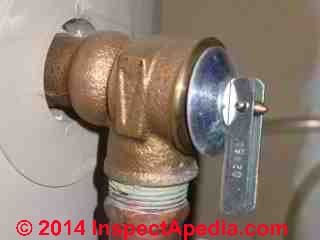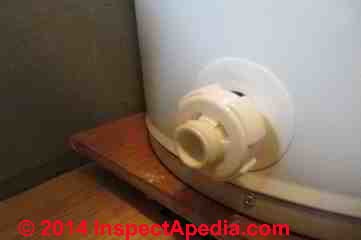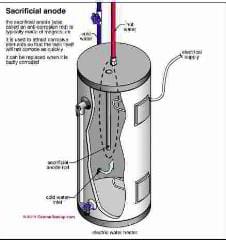 Hot Water Heater Piping Connections & Installation
Hot Water Heater Piping Connections & Installation
Piping connections for individual vs. cascaded, ganged, series, or parallel water heater hook-ups
- POST a QUESTION or COMMENT about diagnosing & repairing hot water heaters.
Water heater piping installation & connections:
Here we describe the plumbing connections and piping options for hot water system hook-ups. We explain the piping for a basic water heater installation compared with options for connecting hot water heaters in parallel, in series, or ganged.
Included ar typical time estimates to install a water heater. Plumbing war story: geyser wars: what can go wrong when installing a part on a water cylinder (water heater). We describe a water heater relief valve repair catastrophe when just touching parts leads to a flooded basement.
Page top sketch provided courtesy of Carson Dunlop Associates, a Toronto home inspection, education & report writing tool company [ carsondunlop.com ].
InspectAPedia tolerates no conflicts of interest. We have no relationship with advertisers, products, or services discussed at this website.
- Daniel Friedman, Publisher/Editor/Author - See WHO ARE WE?
Water Heater Installation Hookup: Piping Arrangements: single, serial, parallel installations
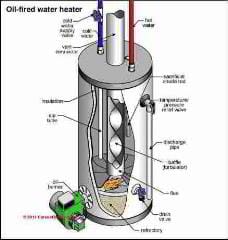
Reader Question: in a parallel water heater hookup do both heaters work at once?
My boyfriend is a long time plumber in a small town here in Northern Calif. He wanted me to look up Parallel plumbing on two water heaters for opening a new bar.
I found two sites with the same hookup Cold water to Cold Water and Hot to Hot on cold water. He took the diagram and all the wholesalers in The Chico calif. were perplexed as to why this was shown this way.
Is this a mistake? Or is there an advantage to taking water from bottom of tank. Does this work both at same time or just one at a time.
I found this to be a challenge to see if this was something very ingenious and would like to make sure and understand and share that maybe you are getting more hot water this way or it's a mistake is labeling. Note: see how the cold and hot are hooked up. Thanks for your time in this matter, my boyfriend hooked up the units as always but, my question wants to see if this is more efficient in a bar setting needing more hot water. - C.B. 8/5/2013
Illustration provided Courtesy Carson Dunlop Associates, used with permission
Reply: Piping Connections for Individual & Ganged Water Heater
I'm not sure I have a clear picture of the question but it seems to me that
1. For all conventional vertical reservoir-type tank-type water heaters, we always take hot water from water that is near the top of the tank interior ( hot water rises to the top of the tank interior regardless of how the water is being heated; cold water flowing into the tank to be then heated is delivered to the tank bottom) when delivering hot water to the building
2. There are very different reasons for hooking up multiple water heaters in series versus in parallel as I outline just below
Hooking Up Water Heaters in Series - cascaded water heaters to handle varying demand
In series hookups the hot water out of heater 1 is taken into the cold inlet of heater 2 and the hot water outlet of heater #2 then feeds the building.
This approach is often used for both heating and hot water heating in large buildings and is sometimes called a cascade approach; with proper heater control settings it allows very economical heater operation - we just run one smaller heater when demand is low, but we can run two or more heaters when demand is greater;
In a cascade arrangement the heaters downstream from the first one act as boosters and turn on only as needed.
A variation of the cascade approach is to install a simple water stoarge tank indoors ahead of the heater; water in the storage tank absorbs heat from the ambient indoor environment before feeding the water heater - reducing the heater's workload.
Hooking Up Water Heaters in Parallel - Case 1 parallel water heaters provide individual building area hot water OR Case 2 parallel water heater hookups provide high constant hot water output volume to a single user
Parallel water heater hookups (Which I think you are describing) basically are feeding cold water in parallel to multiple water heaters (i.e. simultaneously) and the outpout from each of the heaters (the hot out) feeds either different building areas, apartments, or users (case Parallel 1) , or feeds a manifold that then joins the output from all of the heaters to feed a single hot water line feeding a large building (case Parallel 2).
Parallel 1 is what we would expect to see in a small apartment building or multifamily house - essentially each tenant has their own water heater - common cold water in but individual hot water out is fed to each tenant or apartment or building area. This approach is economical and allows each tenant to be charged for their individual water heater use (if metering is installed).
Parallel 2, which I've heard-of but never seen and which I think has less application, is in my OPINON an inefficient variation on the cascade water heater approach designed to give a high hot water output quantity to a single destination.
Watch out: keep in mind that there is good reason that the incoming cold water must be connected to the "COLD" marked inlet on the water heater, as the manuacturer specifies - a dip tube is delivering cold water to the heater tank bottom. Hooking up a water heater backwards gives bad results.
For your boyfriend's case, hooking up hot water supply for a bar, to decide how to hook up his two water heaters depends on what problem he's solving. if the problem is adequate total hot water quantity when hot water demands vary significantly over time then he'd want to use the cascade approach - hook up the heaters in series.
If for some reason he has no room for a larger capacity single water heater but needs a large quantity of hot water always available then a parallel hookup (Parallel hookup case 1 above) might be usable.
You didn't say what energy source these heaters use - I'm guessing they are electrical, but the parallel / series hookup question and answer remains the same for all energy sources. At the end of the day I wonder if we were not a bit confused about "parallel" vs "series" hookups of hot watrer sources. If I've misunderstood your situation or question please let me know.
Watch out: your boyfriend, being a plumber, will doubtless convirm another little installation detail that we mention for other readers: the water heater shutoff valve should be only on the cold inlet side of the heater. A shutoff valve on the outgoing hot side of the heater - right at the heater, invites a disaster.
See BLEVE EXPLOSIONS
Now what happens if we hook up two or more water heaters in series? The hot out of heater 1 enters the cold inlet to heater 2. But I would not install a shutoff between the two water heaters - doing so creates the same unafe condition. What does the plumber say about shutoff valve locations on a multi-heater installation in series?
Reader Question: how to assure equal hot water flow from multiple water cylinders (geysers, water heaters)
[Click to enlarge any image]
As Carson Dunlop Associates ' illustration (left) shows, one way to improve hot quantity in a building is by hooking up more than one water heater, in parallel or in series.
On a “two hot water cylinders” install, how do you ensure equal flow from each cylinder?
Ref your diagram third down this page HOT WATER QUANTITY IMPROVEMENT - D.R. 2016/01/02 U.K. reader
Reply: easy & hard solutions for balancing hot water supply suggest piping water heaters in series or staged
Good question, D.R. A simple approach is to install an automatic, adjustable flow balancing valve on the heater outlets, but Watch Out: never install a valve that can close off all hot water outlet or you may be asking for an exploding water cylinder.
If two water heater cylinders are next to one another the solution is easier as we can make the input supply pipe lengths equal to each of them from a common tee point, and we can join their outlet pipes at a second outlet tee common point again making sure that lengths, elbows, etc. are the same between the two heaters.
But if you do not combine the heaters close to one another and or even then, if the outlet piping lengths, number of bends, altitude, and actual time and flow rate of hot water usage is not identical, the flow will be uneven out of the heaters.
I prefer piping water cylinders in series in a cascade design for more economical hot water production - that avoids the question entirely.
Reader follow-up:
Cracking reply. Thank you. I think my customer is in for some bad news ... His pipes are totally NOT symmetrical and as I thought that is probably his problem with only one of the two identical cylinders supplying a barn conversion! - D.R.
Reply:
Interesting. Depending on how the water heaters are located and how their use is intended, I'd consider a revision to pipe them in series rather than in parallel. If you're not familiar with that approach see the article on this page beginning at WATER HEATER PIPING
The in-series allows you to use one of the heaters to boost temperature when the hot water in the other has begun to run out - reducing hot water cost while still providing more hot water quantity. There are a couple of approaches depending on how you set the thermostats but bascially the second of the in-series heaters doesn't turn on until cold water enters it from the now-used-up first water cylinder.
In contrast, an in-parallel piping means that if you could balance the flow, you're providing an equally-large reservoir of hot water even if, as demand varies, you didn't need it. That is, both water heaters will always have to run when any hot water is used from the pair of them.
More suggestions are at HOT WATER PRESSURE IMPROVEMENT
- DF
Water Tank Piping Connections & Number of Pipes Can Identify the Original Use of Storage Tanks
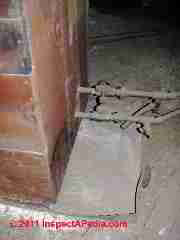 Shown at left are two of five water pipe connections found at an antique water storage tank fonund in the attic of a California home. That tank was ultimately identified and described in detail
Shown at left are two of five water pipe connections found at an antique water storage tank fonund in the attic of a California home. That tank was ultimately identified and described in detail
at SOLAR WATER HEATER ANTIQUE.
The following piping arrangements are discussed in more detail
- One or two pipe connections: an attic expansion tank may have just two pipe connections, one feeding heating water from a hot water heating system into the expansion tank and a second providing overflow drainage.
- Two or three pipe connections: An attic cistern typically has an inlet pipe supplying water to the cistern, sometimes from roof drainage, and an outlet pipe supplying water to the building, and an overflow pipe shoudl the cistern otherwise be subject to over-filling and spillage.
- Four pipe connections: a range boiler typically has four pipe connections: two circulating water through the heatin boiler heat exchanger or a side-arm coil to heat the water in the tank and a cold water inlet from the building water supply along with a hot water outlet supplying building water fixtures.
The range boiler and any other water storage tank that operates under pressure should also have a relief valve that in turn may also be connected to a discharge tube to prevent scalding a bystander. - Four or five pipe connections: a water heater and hot water storage tank designed as a solar water heater or range boiler will typically have four pipe connections:
two lines run to and from the water heating source, possibly circulating by convection with cold water leaving the tank bottom and warm or hot water entering higher on the tank
; two other lines will feed cold water supply into the storage tank and hot water out of the storage tank headed for building plumbing fixtures.
A fifth pipe may provide an overflow drain - Piping for solar water heater systems is described
at SOLAR HOT WATER HEATERS
and at SOLAR WATER HEATER ANTIQUE - Piping for range boiler water heaters is described at PLUMBING CONNECTIONS FOR A RANGE BOILER
- See RELIEF VALVE, WATER HEATER for details of how the discharge pipe is connected at a relief valve or TP Valve
- Also see HOW TO IDENTIFY THE ORIGINAL USE OF WATER TANKS FOUND IN OLDER HOMES
- Also see TANK TYPES: EXPANSION, OIL, SEPTIC WATER, ALL
Water Heater Piping Time & Cost Estimates
Reader Question: 9/11/14 If a contractor had the tools and parts present, what is your rough estimate of the amount of time needed to replace a hot water heater feeder if there weren't any technical issues involed. Is it a fairly easy job?
Thanks in advance
- A.S. 9/11/2014
Reply: it depends
I'm sorry but that question is a bit tricky to even try to answer.
There are just too many variables in any plumbing installation to give a number for plumbing work when we have not a shred of information about the job.
I'm not even sure what you mean by "hot water feeder" nor what is involved: piping, lengths, number of connections, accessability, time to drain existing plumbing, re-fill, valves, mounts etc.
Just look at the water heater installed in our photo at left: the location along will add considerable time to any work that has to be done on this unit.
You might as well as me how long will it take me to drive to Christchurch.
Christchurch in what country? From where?
Are we already in New Zealand?
Are we on the North or South Island?
Where are we?
Do we have a car? Or do we need to hire one and get it out of the lot?
Is there traffic?
Do I have to stop for petrol?
Typical Residential Water Heater (Cylinder) Installation Times
There are construction guides with standard "job times" that one could consult but those offer time ranges that do not allow for problems that might be encountered. I'll give an example in a moment.
- Typical time to remove an old water heater: 45 minutes to an hour
- Time to position the new water heater in place: 30 minutes
- Time to complete connections to the new water heater and place it in operation: 45 minutes to an hour.
I make that 2 to 2 1/2 hours if nothing goes wrong. Just below is an example of what can go wrong.
Water Heater Relief Valve Repair Catastrophe
What Could Go Wrong When Tring to Fix a Part on a Water Heater? Why might a plumbing repair job cost more than the original estimate?
In explaining why plumbing job time & cost estimates are just that: estimates, let's use a real-world example of a simple plumbing task: the installation of a temperature & pressure relief valve (safety valve or TP valve) on an older water heater that is itself already in place.
At a home inspection I noticed that a water heater (cylinder) had no pressure/temperature relief valve installed: instead there was a pipe plug screwed into the opening where the TP valve belonged.
Watch out: I informed both the home buyer and the homeowner that this was a dangerous situation as an un-protected water heater, if overheated, can explode, causing a BLEVE explosion that can cause serious damage, injury, even death. For details
see BLEVE EXPLOSIONS
I explained that the part itself (a water heater safety valve) was not expensive (less than $50. NZ) and that IF nothing went wrong the installation would be quick: simply unscrew the pipe plug, screw in the TP valve, install a discharge tube, and go. Probably less than an hour of time for the plumber.
The home buyer understood and was not panicked.
The home owner, an elderly woman, began to cry.
"You could fix it!" she wailed. "Pleeeeeease fix it!"
"I could fix it," I answered," but it would be unethical for me to both point out work needed during a home inspection and then offer to perform the work. There is an innate conflict of interest in such operations."
"But I'm a lonely frail widow, living waaaay out here in the country, allll alone, I'll never get a plumber to come out here" she continued.
This debate whined on for a time. The home buyer looked at me with a funny glint in his eye, then he suggested that it would be fine with him if I fixed the water heater TP valve problem.
"I don't have my plumbing tools, no parts, nor anything I need," I continued. "I'd have to return later with the TP valve, pipe dope, tools, and so on" I explained. "
Starting Plumbing SNAFUS:
Then I made my first mistake (of that day).
"OK, OK, I'll agree to do this repair work but only on a 'pro-bono' basis -that means for no fee. The owner can instead make a contribution to a local charity for what a plumber would have charged for a service call. We'll call it $100. OK?"
OK - everyone agreed
Continuing my demonstration of idiocy I drove 40 minutes back to my shop, tossed my plumbing tools in the truck, stopped off at Davies Hardware (106 Main St., Poughkeepsie, NY) to pick up a new TP valve and some new teflon tape.
It was surely the case that these would be all the parts I'd need. I already had an appropriate threaded adapter and section of 3/4" copper piping to use for the discharge tube.
I drove 40 minutes back to the job.
Plumbing job time to define the work, get tools & parts, & get to the job:
- 15 minutes of pre-job discussion, (I won't count time to discover the problem nor time for other unrelated tasks).
- 80 minutes of travel
- Total time to this point: 95 minutes before the work could begin.
At the job site I looked at the water heater again. This was a home built in the 1960's.
Snafu #1: I tried shutting off water to the heater
Not one of the shutoff valves in the building itself worked: not at the water heater nor anywhere else. All were either missing completely or were frozen solid. No worries! We could just shut off the well pump and drain pressure from the system.
Snafu #2: this was a big one. I touched the water heater drain valve
I decided to hook up a garden hose to enable draining pressure off of the building plumbing system and out of the water heater (cylinder) itself, sufficient to lower water level below the TP valve opening on the side of the water cylinder tank.
Easy. One just connects a garden hose to the water heater tank drain at the tank bottom, then carries the other end outside or to a suitable drain location.
I made a big mistake. Realizing that all of the other stop valves and shutoffs I'd seen in the building were jammed, I thought I'd just try to open and shut that water cylinder drain a bit to see if it worked.
I just touched the handle. Just touched it, I swear. I never even tried to turn it. I just touched it on one edge.
WHAM! SPEW! the handle blew off of the water heater drain. The valve top and valve stem shot into the air and whacked into the basement ceiling, and water geyser ed into the air in a hot fountain.
The owner had dozens of cardboard boxes of stuff stored on the basement floor. This was going to be a catastrophe.
No worries, I could just shut off the well pump so that we'd only drain 40 gallons of water onto the basement floor and onto the boxes of stuff stored there.
SNAFU #3: I tried to turn off power to the well pump
First off the well and pump and pressure tank were not in nor near the home but were about 100 yards up in the woods in a well pit
See WELL PITS if you don't know what these holes are.
I ran 100 yards up to the well pit, kicked away snow, banged on the cover to dislodge it from being frozen in place.
Adrenalin gave me strength to toss aside the huge, heavy well pit cover. And there was the well pit: with three feet of water covering most of the equipment and a fuse box mounted on the wall to power the well pump.
Only an idiot would jump into three feet of water and try flipping an electrical fuse box switch. Well I had already shown who was an idiot but plumbing job time was one thing, life another.
I ran 100 yards back to the house to grab a broom.
I ran 100 yards back to the well pit and used the broom handle to push down the fuse switch.
Happily SNAFU 3a did not occur: the fuse switch did indeed shut down the pump without falling into the water.
By now I had run 300 yards, risked electrocution, got the well pump OFF, AND there was 2" of water all over the basement floor.
Other methods for shutting off building water supply in an emergency are
Plumbing job time to get the water shut off & drain pressure off of the water heater:
- 20 minutes
- Total plumbing job time to this point: 115 minutes
SNAFU #3: Remove the pipe plug screwed in where the TP valve belongs
This snafu was predictable: the pipe plug and tapping were rusted solid. At this point any sane plumber would have insisted on replacing the whole water heater. Instead I grabbed a bigger wrench. Stop laughing!
With brains and brawn I got the pipe plug out of the tapping. But the threads into which the new TP valve would have to screw were rusted beyond re-sealing with the new relief valve. Again, at this new point any sane plumber would have insisted on replacing the whole water heater.
A sort of insanity set in. A battle, no a war, between me and the damned heater. I was losing.
Plumbing time to get the new TP valve screwed in and sealed in the water heater
- 40 minutes back to Davies Hardware to buy a 3/4" pipe thread chase/tapping tool to clean up the rusted threads and a bottle of LeakLok sealant to be applied (with care so as not to subvert the new TP valve). While at Davies' I also picked up a replacement water heater tank drain valve
- 40 minutes back to the job site
- 8 minutes to re-chase the tapping in the water heater tank and clean the opening
- 2 minutes to install the TP valve
- 5 minutes to cut and solder a thread adapter and fit the discharge tube
- 10 minutes to remove the worthless water heater tank drain valve and install a new one.
- These steps took about another 95 minutes
- Total plumbing job time to this point: 115+ 105 = 220 minutes
With the new parts on the water heater it was time to turn water pressure back on, refill the heater, turn it on, and check for leaks.
Plumbing time to return the water cylinder (water heater) to service
- I walked (exhausted) back to the well pit, use a broom to return power to the lethal flooded well pit pump
- Restore the well pit cover
- Document and warn the owner of the shock hazards at the well pit (buyer already knew this)
- Back to the house, run hot water, re-fill the water cylinder tank, after falling briefly to my knees to thank G_d that in the course of shutting off all water supply I'd not also run into a problem of a lost prime at the well pump.
- Turn on the water heater (cylinder)
- Watch for leaks (there were no more leaks)
- These steps took another 45 minutes
- Total plumbing job time to this point: 220 + 45 = 265 minutes
Plumbing time to help owner mop up basement flood & move cardboard boxes
I know some fellows would have been in their truck long before all of this, but really? Leave a soggy sobbing widow sopping up a basement flood?
- Mop up basement, turn on fans, move boxes
- These steps took another 2 hours and 15 minutes (135 minutes)
- Total plumbing job time to this point: 265 + 135 = 400 minutes - nearly 7 hours to "just install a simple TP valve"
Drive time back from the job is usually not billed by the plumber so we'll eschew that final 40 minute trip back to Poughkeepsie.
Total time to install a TP valve on a nasty corroded old electric water heater: 6.7 hours.
What really ticked me off: the homeowner never made the requested contribution of $100. to the Poughkeepsie shelter.
...
Continue reading at PLUMBING SYSTEM INSPECT DIAGNOSE REPAIR - home, or select a topic from the closely-related articles below, or see the complete ARTICLE INDEX.
Or see WATER HEATER PIPING FAQs - questions & answers posted originally at the end of this page.
Or see these
Recommended Articles
- GAS PIPING SIZE & MATERIAL
- HOT WATER PRESSURE IMPROVEMENT
- HOT WATER QUANTITY IMPROVEMENT
- WATER HEATER PROBLEM DIAGNOSIS
Suggested citation for this web page
WATER HEATER PIPING at InspectApedia.com - online encyclopedia of building & environmental inspection, testing, diagnosis, repair, & problem prevention advice.
Or see this
INDEX to RELATED ARTICLES: ARTICLE INDEX to WATER HEATERS
Or use the SEARCH BOX found below to Ask a Question or Search InspectApedia
Ask a Question or Search InspectApedia
Questions & answers or comments about diagnosing & repairing hot water heaters.
Try the search box just below, or if you prefer, post a question or comment in the Comments box below and we will respond promptly.
Search the InspectApedia website
Note: appearance of your Comment below may be delayed: if your comment contains an image, photograph, web link, or text that looks to the software as if it might be a web link, your posting will appear after it has been approved by a moderator. Apologies for the delay.
Only one image can be added per comment but you can post as many comments, and therefore images, as you like.
You will not receive a notification when a response to your question has been posted.
Please bookmark this page to make it easy for you to check back for our response.
IF above you see "Comment Form is loading comments..." then COMMENT BOX - countable.ca / bawkbox.com IS NOT WORKING.
In any case you are welcome to send an email directly to us at InspectApedia.com at editor@inspectApedia.com
We'll reply to you directly. Please help us help you by noting, in your email, the URL of the InspectApedia page where you wanted to comment.
Citations & References
In addition to any citations in the article above, a full list is available on request.
- Mark Cramer Inspection Services Mark Cramer, Tampa Florida, Mr. Cramer is a past president of ASHI, the American Society of Home Inspectors and is a Florida home inspector and home inspection educator. Mr. Cramer serves on the ASHI Home Inspection Standards. Contact Mark Cramer at: 727-595-4211 mark@BestTampaInspector.com
- John Cranor [Website: /www.house-whisperer.com ] is an ASHI member and a home inspector (The House Whisperer) is located in Glen Allen, VA 23060. He is also a contributor to InspectApedia.com in several technical areas such as plumbing and appliances (dryer vents). Contact Mr. Cranor at 804-873-8534 or by Email: johncranor@verizon.net
- Thanks to Scott C. LeMarr, for sharing his file of keys to decode Furnace and Water Heater Age from the data provided on the manufacturer's equipment labels. Mr. LeMarr is a professional home inspector, Certified Professional Inspector/President, MASTER Indoor Environmental Specialist (MIES). Vice President of Wisconsin NACHI. He and his company, Honest Home Inspections [ Website: www.HonestHomeInspections.com ], LLC. can be reached at 262-424-5587 or by email to scott@honesthomeinspections.com
- SOLAR WATER HEATERS [PDF] , U.S. Department of Energy article on solar domestic water heaters to generate domestic hot water in buildings, explains how solar water heaters work. Solar heat for swimming pools is also discussed.
- HEAT EXCHANGERS for SOLAR WATER HEATING SYSTEMS [PDF], U.S. DOE describes the types of solar water heater heat exchange methods between the sun and the building's hot water supply
- HEAT-TRANSFER FLUIDS for SOLAR WATER HEATING SYSTEMS [PDF] , U.S. DOE, describes the types of fluids selected to transfer heat between the solar collector and the hot water in storage tanks in a building. These include air, water, water with glycol antifreeze mixtures (needed when using solar hot water systems in freezing climates), hydrocarbon oils, and refrigerants or silicones for heat transfer.
- SOLAR WATER HEATING SYSTEM MAINTENANCE & REPAIR [PDF] , U.S. DOE
- SOLAR WATER HEATING SYSTEM FREEZE PROTECTION [PDF] , U.S. DOE,using antifreeze mixture in solar water heaters (or other freeze-resistant heat transfer fluids), as well as piping to permit draining the solar collector and piping system.
- US DOE, SCALING AND CORROSION IN SOLAR WATER HEATING SYSTEMS, U.S. Department of Energy.
- www.energysavers.gov/your_home/water_heating/index.cfm/mytopic=12850 is the base U.S. DOE website for these article
- "Building Owner Water Heater Safety Notice", Building Department, City of Colleyville TX, web search 09/24/2010, original source: http://www.colleyville.com/dmdocuments/Building%20
Owner%20Water%20Heater%20Safety%20Notice%203-6-102.pdf
Quoting:
Water heater safety is imperative to the occupants of a building or structure. If improperly installed, water heaters can be detrimental to the structure, as well as being potentially fatal to its occupants. The proper installation of a water heater is so important that according to Texas State Law all water heater installations must be inspected by a state licensed plumbing inspector. - [20] SCALE FORMATION in WATER HEATERS and METHODS of PREVENTION free download as [PDF] Krappe,
Justus Maximilian, Engineering experiment station. Gas engineering bulletin; no. 6; Research series; no. 74; On cover: Engineering bulletin, Purdue university. Vol. xxiv, no. 3a. June, 1940 (Layfayette Indiana) commonly referred to in some references as "Purdue University Bulletin No. 74" - thanks to researcher Robyn Goldstein for the full citation. LCCN: 40028844 & OCLC: 1038544 - Water analysis, water softening, hot-water supply. 27pages.
You can also obtain this document through your local library. (full copy file at InspectAPedia 3/31/2010) Purdue B074 can be hard to locate online.
Also Bradford White Corporation (a manufacturer of water heaters) previously published
SCALE FORMATION in WATER HEATERS - EXCERPTS [PDF] from that document made available by Purdue University. - Carbon Monoxide Gas Toxicity, exposure limits, poisoning symptoms, and inspecting buildings for CO hazards
- National Fuel Gas Code (Z223.1) $16.00 and National Fuel Gas Code Handbook (Z223.2) $47.00 American Gas Association (A.G.A.), 1515 Wilson Boulevard, Arlington, VA 22209 also available from National Fire Protection Association, Batterymarch Park, Quincy, MA 02269. Fundamentals of Gas Appliance Venting and Ventilation, 1985, American Gas Association Laboratories, Engineering Services Department. American Gas Association, 1515 Wilson Boulevard, Arlington, VA 22209. Catalog #XHO585. Reprinted 1989.
- SOLAR WATER HEATERS [PDF] , U.S. Department of Energy article on solar domestic water heaters to generate domestic hot water in buildings, explains how solar water heaters work. Solar heat for swimming pools is also discussed.
- In addition to citations & references found in this article, see the research citations given at the end of the related articles found at our suggested
CONTINUE READING or RECOMMENDED ARTICLES.
- Carson, Dunlop & Associates Ltd., 120 Carlton Street Suite 407, Toronto ON M5A 4K2. Tel: (416) 964-9415 1-800-268-7070 Email: info@carsondunlop.com. Alan Carson is a past president of ASHI, the American Society of Home Inspectors.
Thanks to Alan Carson and Bob Dunlop, for permission for InspectAPedia to use text excerpts from The HOME REFERENCE BOOK - the Encyclopedia of Homes and to use illustrations from The ILLUSTRATED HOME .
Carson Dunlop Associates provides extensive home inspection education and report writing material. In gratitude we provide links to tsome Carson Dunlop Associates products and services.


